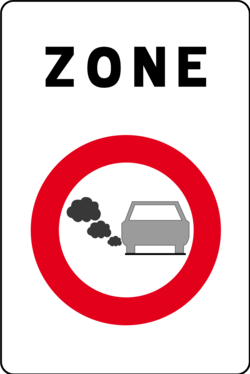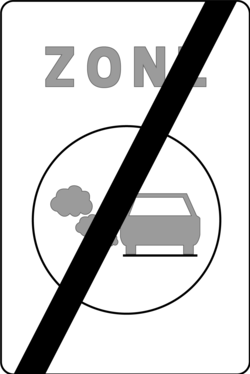Name of the environmental zone: Environmental zone Antwerp - Belgium
Date of entry into effect of the zone: 01-02-2017
Type of environmental zone: Permanent, 24 hours a day
Not allowed to drive (temporarily): Information currently unavailable
Not allowed to drive (permanently): Vehicle class: cars, campers (M1), buses (M2, M3), vans (N1), trucks (N2, N3)
Type of fuel: petrol, diesel, LPG, CNG
Euronorm: 0-1 (petrol, LPG, CNG), 0-4 (diesel)
Badge/registration/authorisation: Entry with registration only (Country of registration: all except Belgium, Netherlands)
Fines: 150 to 350 €
Area/extension of the environmental zone: The area between the entire city centre and part of the district Linkeroever (between the E17, the Park & Ride Linkeroever and the Sint-Annabos) has been declared environmental zone. The environmental zone covers 20 km² and affects about 200.000 inhabitants.
Contact of the environmental zone and exceptions: City of Antwerp, Stadsontwikkeling, Grote Markt 1, 2000 Antwerp, Belgium; info@stad.antwerpen.be
Exemptions: Fire brigade, Police car and Ambulance
What is an environmental zone (LEZ/ZFE/ZBE)?
An environmental zone is a specific area in a city or region that is protected by regulations and restrictions to improve air quality. These zones are usually established to reduce emissions of pollutants such as nitrogen oxides and particulate matter, which are responsible for poor air quality in many cities.
In these zones, certain rules apply to vehicle access based on vehicle emissions. This may include imposing driving bans on certain types of vehicles, such as older diesel vehicles, or requiring the creation of an eco-label for vehicles. This mark, which must be affixed to the vehicle, confirms that the vehicle complies with the applicable emission regulations and is therefore authorized to drive in the low emission zone.
The introduction of low emission zones has led to a significant improvement in air quality in many cities. It has been observed that emissions of nitrogen oxides and particulate matter have been reduced in these zones, thereby improving the health of residents. The number of respiratory diseases and cardiovascular diseases also decreased.
However, it is not just the introduction of environmental zones alone that can lead to an improvement in air quality. It is necessary to take other measures to reduce emissions overall. These include, for example, promoting electromobility, increasing energy efficiency and creating alternative means of transportation such as bicycles and public transportation.
Environmental zones are an important tool to improve air quality in cities and regions and reduce the impact of air pollution on the health of residents. They are used in many European countries and have shown to have a positive effect on air quality.
Environmental zones are also known in other countries as Environmental Zones, Clean Air Zones (England), Miljøzone (Denmark), Miljözon (Sweden), Lavutslippssone (Norway), Alacsony Kibocsátási Övezet (Hungary), Zona ambientale (Italy), Umweltzonen (Germany), Milieuzones (Netherlands), ZFE - Zone à Faibles Émissions (France) and Lage-emissiezone (Belgium), ZBE - Zona de baixes emissiones (Spain).
Winter zone: There are environmental zones which are only seasonally active or have stricter rules for certain months. This means that these zones are active, for example, from September 15 to April 15 of the following year. Outside of this time, no or less strict driving restrictions apply and you can drive freely. One country with many winter zones is Italy.
Antwerp/Ghent
Do I need stickers or registrations?
To enter the low emission zone, each vehicle concerned requires a valid registration. Otherwise a fine of 150 Euro to 350 Euro is to be expected.
How do I recognize the low emission zone?
The beginning and end of the environmental zones are marked with signs. This shows a red circle as a prohibition sign with a vehicle causing emissions. Who exactly is allowed to enter or not is not indicated by the entry sign.
In our Green-Zones App we have a detailed map of each low emission zone. So you can easily recognize the borders and avoid penalties.
Are there other low emission zones in Belgium?
There are 3 low emission zones in Belgium: Antwerp, Brussels and Ghent
In our Green Zones App we have gathered together all the low emission zones in Europe and presented them clearly.
Good to know...
All current driving bans and further information are available in our Green-Zones App.
Are night-time environmental zones coming?
The Berlin Green Party recently presented a proposal to equalise the traffic congestion in the capital. The idea is to shift delivery and commercial traffic to the night-time hours. According to Antje Kapek, transport spokesperson for the Greens, this proposal should help to ensure that delivery vehicles, refuse collection, care services and doctors get stuck less in congested and parked-up streets during the day. Low-noise and low-emission lorries could increasingly drive into cities at night and on special routes.
Bicycle instead of car - Paris in transition
A study by a public foundation has shown that more than one in ten journeys in Paris and the surrounding area are made by bicycle. This is a remarkable increase compared to 14 years ago, when less than one in thirty journeys were made by bike. Paris seems to have been endeavouring to change its transport policy for years. With more cycle paths and cycle lanes, fewer car parks and higher parking charges, the city is trying to promote cycling and reduce car traffic. But what does this mean for the existing low emission zone?




![[Translate to Englisch:]](https://www.green-zones.eu/fileadmin/_processed_/8/3/csm_screenshot_2024-04-18_125614_c7d9eca4a5.png)
![[Translate to Englisch:]](https://www.green-zones.eu/fileadmin/_processed_/2/0/csm_screenshot_2024-04-18_121908_5e1053efaf.png)